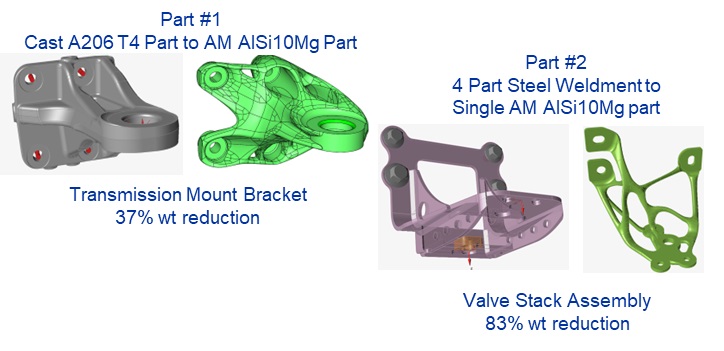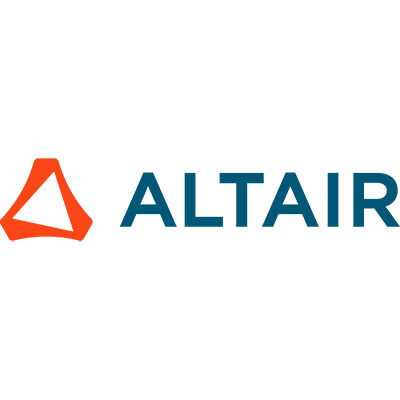


Traditional fabricated designs vs. optimized designs for additive manufacturing reducing the weight of the ground vehicle parts.
Problem
One of the main advantages of additive manufacturing (AM) lies in the ability to produce parts that have been designed for optimal functionality rather than machinability. AM components are not constrained by traditional manufacturing techniques. Many components on current Army ground vehicles could benefit from the freedoms realized with AM, reducing the weight of the vehicle and thus increasing its load- carrying capacity. Utilizing the advantages of AM to create organic shapes through topology optimization that can increase the part’s performance while decreasing its overall weight would be a significant improvement for U.S. ground vehicles offering better performance than traditionally manufactured parts, decreased sustainment burden, increased readiness, alternative sources of supply, and potentially reducing costs.
Objective
The objective of this effort was to demonstrate the advantages of AM through the redesign of a group of Army ground vehicle components to reduce weight. The redesigned parts met all other performance criteria requirements of the traditionally manufactured part. Additional objectives provided documentation and training for Army personnel on software technologies and methodologies for Design for Additive Manufacturing (DfAM) that allow for efficient repetition of the manufactured parts.
Technical Approach
Altair worked with Army Ground Vehicle System Center (GVSC) to strategically select three or four parts for optimization by utilizing a matrix of various components identified by GVSC. The part matrix included an array of parameters such as part size, material, complexity, functionality, interaction with neighboring components, etc. Parts selected within the project were redesigned to meet all performance criteria requirements of the traditionally manufactured parts.
Four areas in the primary workstream focused on identifying, redesigning, and virtual testing of the parts using previously developed methodologies to develop additional use cases demonstrating the overall value to Army-GVSC leadership. First, the strategic part selection used industry-developed methods to identify and pre-qualify Army vehicle components and parts that have the highest opportunity for success using AM. Second, the team applied the DfAM workflow, previously developed, to redesign the top three or four parts identified from the list in the strategic part selection task and dependent upon the design complexity of the selected parts. Third, “virtual testing” was leveraged to minimize the amount of physical testing required to achieve engineering sign-off with modeling, simulation, and testing approaches. Finally, training and training guides outlining DfAM workflows were developed. As the DfAM workflow matured during the project it was formalized, and technologies and methodologies in managing the workflow were explored. Also, additive part costing technologies and methods for cost-per-concept efforts were addressed.
Accomplishments
This project utilized Altair Inspire software to re-design retrofit parts for Army vehicle platforms. The geometric freedom in AM allowed for mass reduction and performance gain opportunities when coupled with the efficient geometries generated by Altair’s topology optimization.
The project resulted in the re-design of three parts: transmission mount bracket, valve stack bracket, and roof hatch hinge. It was demonstrated that significant mass savings can be realized when Altair’s structural optimization technologies and methods are used in developing parts for AM. The transmission mount bracket redesign resulted in 34% mass savings with an improved bushing center stiffness (30% stiffer in vertical load direction). The valve stack bracket redesign resulted in an 83% mass savings combining the traditional four-part weldment into a single part, also reducing the hardware count. The roof hatch hinge redesign provided a 46% mass savings meeting all stress and stiffness targets defined. The designs were performance-validated using Inspire Structural Analysis as well as Inspire Print3D in simulating the laser powder bed fusion (L-PBF) process. The methods employed were documented and used to organize a workflow process and data organization structure. This Design Decision Matrix (DDM) methodology demonstrated an effective means of exploring the design space and efficiently converging on the appropriate mix of cost, weight, and performance. Lastly, custom training and development of a detailed “cookbook” followed the re-design process which provided knowledge transfer of both the tools and methods to the GVSC engineers.
Project Participants
Project Principal

Other Project Participants
- U.S. Army DEVCOM-GVSC (Ground Vehicle Systems Center)
Public Participants
- U.S. Department of Defense
